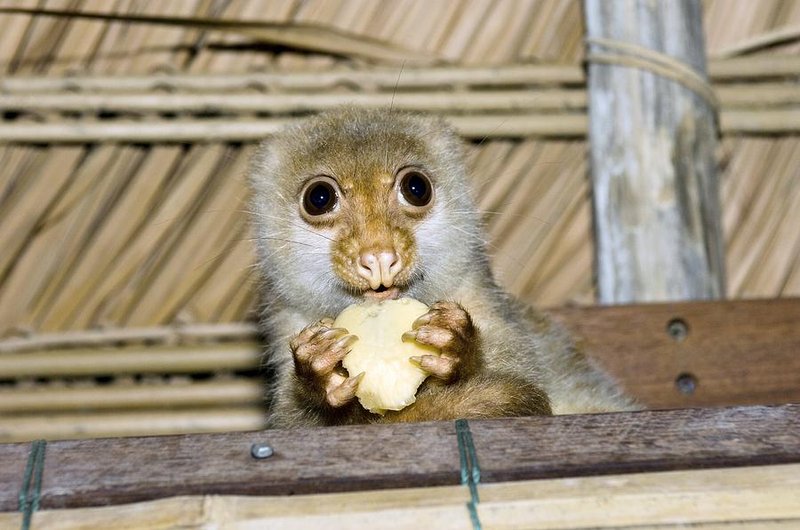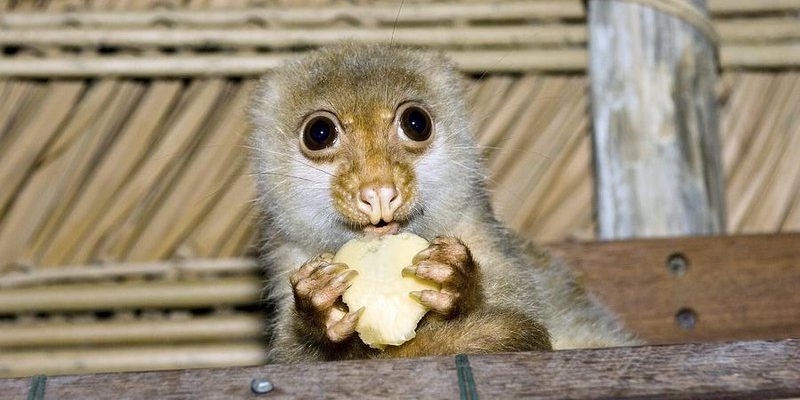
The cuscus is a fascinating marsupial found primarily in New Guinea and surrounding islands. Imagine a small, furry creature, leisurely munching on leaves while hanging from a branch—this is the cuscus in its natural habitat. Known for their adorable faces and gentle demeanor, cuscuses are nocturnal, which means they’re much more active at night. Their unique appearance and behaviors make them a delightful subject of study for wildlife enthusiasts and casual observers alike.
With their large eyes, which help them navigate the dark, and their tufted tails that aid in balancing, cuscuses are perfectly designed for a life in the treetops. They belong to the family Phalangeridae, which classifies them alongside other cutting-edge marsupials. If you think of a cuscus like a tree squirrel—only with more fur and a knack for climbing—you’ll be on the right track!
Despite their cuteness, cuscuses face threats from habitat destruction and hunting, which is vital to consider if we want to understand and protect these enchanting creatures. While they might seem like gentle giants in the animal world, their future is a bit precarious. So, let’s dig deeper into the life of the cuscus and discover what makes these marsupials so special.
Physical Characteristics
Cuscuses are medium-sized marsupials, typically measuring about 12 to 27 inches in length, not including their tails. Their body weight can range from 5 to 20 pounds, depending on the specific species. Many people are struck by their furry, rounded faces which sport large, expressive eyes that give them a rather endearing appearance. Their fur color varies significantly, providing them with excellent camouflage among the lush foliage of their forest homes. Some cuscuses are a bright, creamy yellow, while others display a deep brown or grey coat.
Their tails are another standout feature. Cuscuses have long, prehensile tails, meaning they can use them like an extra limb to grasp onto branches as they maneuver through the trees. This adaptability is essential for their survival, allowing them to navigate their arboreal environment with ease. They also possess sharp claws that help them climb and grip onto branches securely.
One interesting aspect of cuscus anatomy is their unique digestive system, which is well-adapted for their herbivorous diet. They consume a variety of leaves, fruits, and flowers, which provide the necessary nutrients for their growth and energy needs. They have a relatively low metabolic rate, allowing them to survive on a diet that is high in fiber but low in calories—perfect for a life spent foraging in the treetops.
Habitat and Distribution
These fascinating creatures are primarily found in the tropical rainforests of New Guinea and nearby islands, such as the Solomon Islands and parts of Australia. Cuscuses thrive in dense, humid environments where they can easily find food and shelter among the trees. They prefer areas with abundant foliage, which provides both a food source and protection from predators.
You might be wondering what the ideal habitat looks like. Think of lush green canopies filled with a rich variety of plants and fruits. Cuscuses are particularly fond of eucalyptus, acacia, and various fruit-bearing trees. The thick foliage not only helps them hide from predators but also allows them to move through the treetops more easily. When trees are cut down or when forest areas are degraded, it threatens the cuscus population—showing just how interconnected their survival is with their habitat.
Interestingly, cuscuses are not limited to the treetops. While they are primarily arboreal, they can occasionally be spotted on the ground, especially during nighttime foraging adventures. This makes them more versatile and opportunistic feeders, although remaining in the trees helps them evade many of their natural predators, such as snakes and birds of prey.
Diet and Feeding Habits
Cuscuses are primarily herbivores, meaning their diet consists mainly of leaves, fruits, flowers, and even bark. Picture a leisurely evening where they gaze among the branches, selecting the freshest leaves to munch on. They have been known to consume specific leaves that are high in protein, which helps sustain their energy levels while climbing. This dietary preference makes them important contributors to their ecosystems, as they help with seed dispersal and maintaining plant diversity.
One striking feature of their feeding habits is their slow metabolism, which allows them to thrive on a diet that many other animals would find lacking. Their bodies are adapted to efficiently extract the necessary nutrients from fibrous plant material, but this means they must eat quite a bit to meet their energy requirements. Therefore, cuscuses spend a significant amount of their nights foraging for food in the trees and occasionally venturing to the ground to find a tasty treat.
Interestingly, cuscuses have also been observed engaging in a behavior known as “leaf-swallowing.” This involves consuming leaves whole, particularly those that are high in tannins, which helps them extract essential nutrients. It’s like making a gourmet meal in a forest restaurant! Their unique dietary choices and feeding habits greatly influence the ecological balance in their habitats, highlighting the importance of these charming marsupials in their ecosystems.
Reproduction and Lifespan
The reproductive cycle of cuscuses is quite fascinating, and understanding it helps reveal even more about their lifestyle. Generally, female cuscuses have one to two offspring per breeding season, usually during the wet season when food is abundant. After a gestation period of about 11 days, baby cuscuses, known as joeys, crawl into their mother’s pouch for protection and nourishment. This pouch is essential, as it provides a safe space for the young ones to develop during their early months.
After about four months, the joeys start to venture out of the pouch but will continue to nurse for an additional month or two. During this time, the mother will teach them how to forage for food and navigate their environment. It’s like a little training session in the treetops, preparing them for independence. The bond between the mother and her young is strong, and she’ll protect and care for them until they are ready to fend for themselves.
Conservation Status and Threats
Regrettably, cuscuses are listed as near threatened due to various factors impacting their populations. The primary concern is habitat loss, mainly due to deforestation for agriculture and logging. When forests are cleared, cuscuses lose not only their homes but also their food sources. This rapid loss of habitat creates a domino effect, threatening their survival and leading to declining numbers across their range.
In addition to habitat destruction, cuscuses are also threatened by hunting. Locals sometimes hunt them for food or sport, further depleting their populations. This emphasizes the need for education and awareness around sustainable practices to protect these marsupials. You might be wondering, what can we do about it? Supporting conservation efforts, such as habitat preservation and responsible wildlife tourism, plays a significant role in ensuring cuscuses can thrive.
Various organizations and researchers are actively working to protect cuscuses and their habitats. Initiatives focus on creating protected areas, promoting sustainable land use, and educating local communities about the ecological importance of cuscuses. Conservation of these charming animals is not only vital for their survival but also crucial for maintaining the health of the ecosystems they inhabit.
Interesting Facts about Cuscus
| Scientific Name: | Phalangeridae |
| Size: | 12 to 27 inches (30 to 70 cm) in length |
| Weight: | 5 to 20 pounds (2 to 9 kg) |
| Diet: | Herbivore (leaves, fruits, flowers) |
| Habitat: | Tropical rainforests of New Guinea and nearby islands |
| Lifespan: | Up to 10 years in the wild |
| Behavior: | Nocturnal with arboreal tendencies |
FAQ
What is the main diet of a cuscus?
Cuscuses are primarily herbivorous, feeding on a variety of leaves, fruits, and flowers. They have a strong preference for specific plants, particularly eucalyptus and acacia, which provide them with necessary nutrients. Their unique digestive systems allow them to efficiently extract nutrients from fibrous plant materials, which is essential for their survival in the wild.
Are cuscuses dangerous to humans?
No, cuscuses are generally not dangerous to humans. They are shy and gentle creatures that prefer to avoid confrontation. Their main defense mechanism is to hide in the trees rather than interact with humans. However, like any wild animal, they may react defensively if they feel threatened, so it’s essential to respect their space and habitat.
Do cuscuses live alone or in groups?
Cuscuses tend to be solitary animals, especially as adults. They establish their own territories and prefer to forage alone at night. However, during mating season, males and females may come together, and mothers will stay with their young until they are independent. This solitary lifestyle helps reduce competition for food and resources in their forest habitats.
How do cuscuses communicate?
Cuscuses communicate primarily through sounds, body language, and scent marking. You might hear soft cries or grunts as they interact with one another or signal their presence to potential mates. Additionally, scent-marking helps establish territory and communicate reproductive status to other cuscuses.
Are cuscuses endangered?
Cuscuses are considered near threatened, primarily due to habitat loss and hunting. Deforestation, especially for agriculture and logging, poses a significant threat to their populations. Conservation efforts are underway to protect both cuscuses and their habitats, but ongoing awareness and action are needed to ensure their survival for future generations.
What are the differences between cuscuses and other marsupials?
Cuscuses differ from other marsupials in various ways, particularly in their size, habitat preferences, and diet. While many marsupials, like kangaroos, are terrestrial, cuscuses are primarily arboreal. They are also smaller than some of their relatives. Their specialized diet primarily consists of foliage, which can vary significantly from other marsupials that may eat insects or small animals.
Can cuscuses be kept as pets?
While they are adorable, cuscuses are not suitable pets for the average person. They are wild animals with specific needs related to their diet, habitat, and social structure. Keeping them as pets can lead to health problems for the animal and is often illegal in many areas. Instead, they are best appreciated in their natural environments or in wildlife sanctuaries where they can be cared for properly.
What role do cuscuses play in their ecosystem?
Cuscuses play a vital role in their ecosystems as herbivores. By consuming leaves and fruits, they help maintain plant health and diversity and engage in seed dispersal. This interaction supports the growth of various plant species and contributes to the overall balance of their forest habitats. Protecting cuscuses means safeguarding the intricate web of life that depends on them.
How can I help protect cuscuses?
You can help protect cuscuses by supporting conservation efforts aimed at preserving their natural habitats. Consider donating to wildlife organizations focused on rainforest preservation or participating in eco-friendly tourism that promotes responsible wildlife observation. Educating others about the importance of cuscuses and the threats they face can also make a significant difference in conservation efforts.

